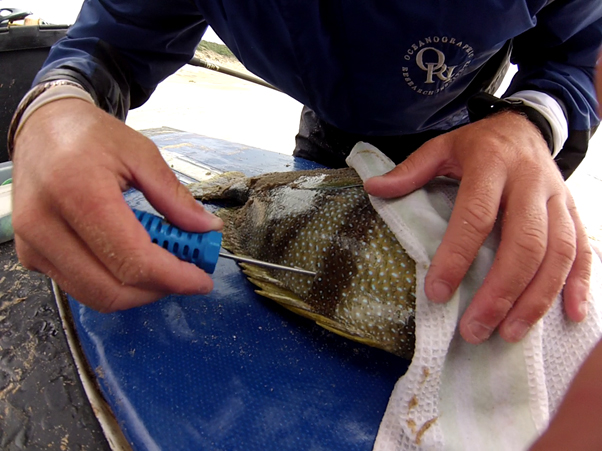Tagging is an important technique fishery biologists use to study individual aquatic animals (e.g. fish) or populations. They will generally tag or mark aquatic animals to obtain important information necessary for research or management. By reporting tagged or marked fish (i.e. a recapture), you can assist in:
1- Stock identification -determining whether stocks or sub-populations are connected and are being utilized for sport or commercial fisheries
2- Migrations - figuring out the path and distance of migration, rate of movement, and homing tendencies of a particular species
3- Behaviour - identifying factors that limit abundance such as habitat selection and intra- and inter-species interactions
4- Age - validating the age of fish, particularly for aging methods (e.g. counting growth rings on a scale) and determining growth rates
5- Mortality rates - following the effects of natural and fishing mortality on a fish population
WHAT FISH ARE ELIGIBLE FOR TAGGING?
The ORI-CFTP is strictly a marine based project. This means we do not tag freshwater fish species, although we do tag fish in estuarine environments. A large variety of species are eligible to be tagged as part of the project, although fish less than 30 cm (0.5 kg) are not tagged. Please download the latest priority species list. There are many different types of tags used on different fish species (e.g. satellite tags, acoustic tags, archival tags, etc.). The ORI-CFTP use external dart tags, which consist of a monofilament vinyl streamer attached to a plastic barb, much like a miniature version of a spear from a speargun. Each tag is inscribed with a unique alpha-numeric code (e.g. D123456) and contact details (i.e. email address, cell phone number and postal address).
Tags are generally inserted with a sharp, hollow, stainless steel applicator, into the dorsal musculature of a fish or shark, although this may differ in certain fish species (e.g. rays). There are three types of tags used on the ORI-CFTP. These include A-tag (sharks and rays and large bony fish >60cm), D-tags (smaller bony fish between 30 and 60 cm in length) and M-tags (billfish and large tuna >25 kg). Tags are generally inserted with a sharp, hollow, stainless steel applicator, into the dorsal musculature of a fish or shark, although this may differ in certain fish species (e.g. rays). Upon initial tagging (and subsequent recapture of a tagged fish) anglers record the following information: tag number, fish species, length (fork/total/precaudal/disk width), exact locality and date. The use of external tags by the ORI-CFTP is particularly favourable as it is relatively cheap compared to other tagging methods, relatively little training is required to insert tags, no software is required to download information from each tag, and the tagging equipment is very basic. This allows a relatively large number of fish to be tagged fairly economically and allows citizens who are not trained scientists to be involved, similar in some respects to the South African Bird Ringing Unit. However, considerable attention has been focused on ensuring that the best available tag and tagging equipment is used and that our taggers are shown how to handle and tag fish correctly, in order to minimize post-release mortality.

HOW TO BECOME A MEMBER
If you are interested in making a significant contribution to conservation and management of our marine linefish species, live near the coast, fish often and know your different fish species then please complete an application form to apply to become a member of the ORI-CFTP. An email will be sent to you once your application has been submitted. You will be notified if your application is successful and will be required to purchase a starter kit with everything you need, including instruction manual, tape measure and tagging equipment (dart tags and applicator).
HOW TO TAG FISH
If you are interested in learning how to handle and tag fish correctly please consult the following material. If you follow these guides you will be on your way to successful tag and release.

